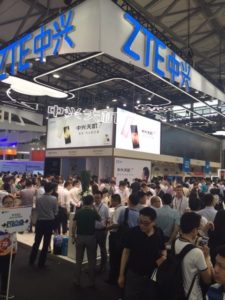We’re back from Mobile World Congress Shanghai, where FindBiometrics President Peter O’Neill moderated two sessions of keynotes and panels. The three day event market the largest mobile industry conference in Asia, and like the original Mobile World Congress, held annually in Barcelona, MWC Shanghai provided a snapshot into the dominant trends in mobility today.
Here are three big trends we saw at MWC Shanghai last week:
The 5G Future

5G was the talk of the town at MWC Shanghai, with presentations, demonstrations, and panels on the next generation of wireless network infrastructure. Ericsson has pegged 5G as being ready for commercial products by 2020, and with it will come the lofty promises of high speed, low latency, and built-in security. The vertical markets of healthcare, financial, automotive, industrial IoT, and more stand to benefit greatly from 5G, which will be able to boast fiber-optic levels of performance as well as data privacy enabled by network slicing.
On day one of the conference, at the FindBiometrics moderated Identity & Personalisation keynote session, Ulf Ewaldsson, Senior Vice President, Group CTO and Head of Group Function Technology at Ericsson, spoke on how the mobile networks of the future will be secured by GSMA Mobile Connect. On day two, Jonathan Olsson, Solution Manager, Group Function Technology at Ericsson, and Giuseppe Targia, VP, Security & IoT Business Unit at Nokia, participated in a 5G focused panel with Peter O’Neill. 5G was also on the showroom floor, with major demonstrations punctuating the mobile tech exhibition.
Smart Cities and IoT

One of the benefits of 5G will be its major enabling of Internet of Things and Smart City applications. So it makes sense that a mobility conference focused so strongly on 5G also had a strong IoT presence. The next generation of wireless infrastructure stands to bring with it a great many automation and connected society use cases.
Ericsson, China Mobile and Intel worked together in a Smart City demonstration that helped to illustrate what our connected world might look like in the near future—combining multiple technologies that helped monitor environmental conditions. Oberthur Technologies CEO Didier Lamouche, meanwhile, highlighted the critical importance of user security in the emerging IoT landscape during a keynote presentation.
“We won’t see any massive scale up of IoT usage unless the consumer is fully secure and his privacy is fully ensured,” remarked Lamouche.
Bringing things to a regional focus, the GSMA released a new report at MWC Shanghai painting a picture of China’s massive potential in the M2M market.
Biometrics For The People

As connections continue to proliferate and life becomes increasingly mobile, consumer biometrics are in greater demand. Identity management is a key component in a connected world and biometric authentication provides the necessary convenience and security to serve and protect end users properly. NTT Docomo, whose CEO proclaimed the company as being five to ten years ahead of its global peers in an MWC Shanghai keynote, clearly understands this as a member of the FIDO Alliance and the pioneering MNO is consumer iris recognition on smartphones.
Of course, mobile consumer biometrics equate to more than just slapping a fingerprint sensor on a phone. Biometrics need to fit into the lives of end users in order to find proper adoption. And to that end Sensory CEO Todd Mozer revealed his company’s findings regarding user preferences in contactless biometric modalities. In a keynote during the FindBiometrics moderated Cyber Security session, Mozer detailed the data collected from the company’s free AppLock app available through Google Play. The results are fascinating, especially those dealing with minute preferences such as face obscuring during authentication, but over all Sensory found that ease of use is critical for the consumer adoption of biometrics.
*
For more MWC Shanghai coverage check out our weekly roundup features on FindBiometrics and Mobile ID World.
—
July 5, 2016 – by Peter B. Counter


Follow Us